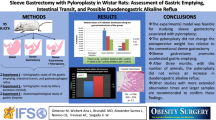Summary
The purpose of this study was to find whether the reflux of bile and pancreatic juices following stomach resection (duodenogastric reflux) enhances the incidence of carcinomas near the gastroenteric anastomosis. 72 male Wistar rats were subjected to stomach resection. The gastroenteric anastomosis (GE) was performed either as short loop anastomosis (Billroth II;n = 39), thus providing a continuous duodenogastric reflux, or as Y-shaped GE (according to Roux;n = 33). By the latter technique, bile and pancreatic juices are derived quantitatively into the jejunum without coming into contact with the remaining part of the stomach. During a period of 33 weeks, operated rats as well as intact animals were given the carcinogen N-methyl-N′-nitro-N-nitrosoguanidine (NG; 120 mg/1) in the drinking water. At autopsy, 33 to 36 weeks after daily oral administration of NG, most of the tumours were found in operated rats undergoing continuous ref lux (Billroth II group). In contrast to these findings, the incidence of carcinomas was significantly lower in animals without reflux (Roux group or intact control rats).-The results of our experiments demonstrate that, in rats, the duodenogastric reflux contributes substantially to the development of carcinomas of the resected stomach.
Zusammenfassung
Es wurde die Frage geprüft, ob obligater duodenogastrischer Reflux unter Langzeitbedingungen das Wachstum von Carcinomen oder Sarkomen im resezierten Magen beeinflußt. 72 männliche Wistarratten wurden einer Magenresektion unterworfen. Die erforderliche Gastroenteroanastomose wurde bei 39 Tieren als short loop GE (Billroth II) mit obligatem Reflux von Galle und Duodenalsekret in den Restmagen angelegt. Die restlichen 33 Tiere erhielten eine Y-förmige GE (nach Roux) mit seitlicher Einmündung des Duodenum in den Dünndarm; Reflux von Galle in den resezierten Magen war dadurch unmöglich. Die Carcinominduktion erfolgte durch kontinuierliche Gabe von N-Methyl-N'-Nitro-N-Nitrosoguanidin im Trinkwasser. Bei der Sektion der Tiere mit Reflux 33 Wochen nach Carcinogengabe fand sich die Mehrzahl der malignen Tumore von Magenstumpf, Anastomose (GE) und angrenzendem Dünndarm in der Tiergruppe mit obligatem Reflux (13 von 22). Die Tiergruppe ohne Reflux (Y-Roux GE) wies demgegenüber signifikant weniger Carcinome auf (7 von 21); die Tumorincidenz dieser Gruppe entsprach derjenigen eines nicht operierten Kontrollkollektives (5 von 22). - Die Ergebnisse unserer Untersuchungen zeigen, daß die in der Technik des short loop durchgeführte Gastroenteroanastomose des Billroth 11-Magens das Krebswachstum im Anastomosengebiet in besonders ausgeprägtem Maße fördert. Ausschlaggebend für die gesteigerte Carcinominduktion ist der chronische Reflux von Galle und Duodenalsekret, der bei der short loop-GE obligat über den Magnrest fließt.
Similar content being viewed by others
Literatur
Black, R. B., Hole, D., Rhodes, J.: Bile damage to the gastric mucosal barrier: the influence of pH and bile acid concentration. Gastroenterology61, 178 (1971)
Clémençon, G., Baumgartner, R., Leuthold, E., Miller, G., Neiger, A.: Das Karzinom des operierten Magens. Dtsch. med. Wschr.101, 1015 (1976)
Dahm, K., Werner, B.: Das Karzinom im operierten Magen. Dtsch. med. Wschr.100, 1073 (1975)
Dahm, K., Werner, B.: Experimentelles Anastomosencarcinom. Ein Beitrag zur Pathogenese des Magenstumpfcarcinoms. Langenbecks Arch. Chir.333, 211 (1973)
Dăhm, K., Eichen, R., Werner, B., Kozuscheck, M.: Gastroenterale Anastomosen und konsekutiver Krebs im Restmagen. Chirurg47, 494 (1976)
Davenport, H. W.: Destruction of the gastric mucosal barrier by detergents and urea. Gastroenterology 54, 175 (1968)
Geall, M. G., Phillips, S. F., Summerskill, W. H. J.: Profile of gastric potential difference in man. Effects of aspirin, alcohol, bile and endogenous acid. Gastroenterology 58, 437 (1970)
Grant, R., Grossman, M. I., Wang, K. J., Ivy, A. C.: The cytolytic action of some gastrointestinal secretions and enzymes on the epithelial cells of the gastric and duodenal mucosa. J. cell. Physiol.37, 137 (1951)
Ivey, K. J., DenBesten, L., Clifton, J. A.: Effects of bile salts on ionic movement across the gastric mucosa. Gastroenterology59, 683 (1970)
Rehner, M., Soehendra, N., EichfuB, H. P., Dahm, K., Eckert, P., Mitschke, H.: Friihkarzinome im (Billroth II-)Resektionsmagen. Dtsch. med. Wschr.99, 533 (1974)
Saito, T., Inokuchi, K., Takayama, S., Sugimura, T.: Sequential morphological changes in N-Methyl-N'-Nitro-N-Nitrosoguadinine carcinogenesis in the glandular stomach of rats. J. nat. Cancer Inst.44, 769 (1970)
Werner, B., Leppin, A., Seiler, I., Mitschke, H., Soehendra, N., Farthmann, E., Rehner, M., Dahm, K.: Duodenaler Reflux und Gastritis im Billroth-l-Magen. Dtsch. med. Wschr.100, 2385 (1975)
Author information
Authors and Affiliations
Additional information
Mit Unterstützung der Deutchen Forschungsgemeinschaft
Rights and permissions
About this article
Cite this article
Dahm, K., Eichen, R. & Mitschke, H. Das Krebsrisiko im Resektionsmagen. Langenbecks Arch Chiv 344, 71–82 (1977). https://doi.org/10.1007/BF01259380
Received:
Issue Date:
DOI: https://doi.org/10.1007/BF01259380




